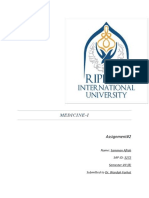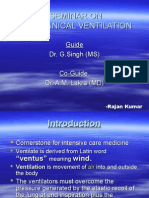0 ratings0% found this document useful (0 votes)
141 viewsRFT (Respiratory Function Testing)
Respiratory function tests objectively measure lung function for various clinical purposes, including detecting and quantifying cardiopulmonary disease and monitoring treatment response. Tests are classified as evaluating respiratory mechanics, pulmonary gas exchange, or exercise capacity. Spirometry assesses airflow by measuring the volume of air inhaled and exhaled; lung volumes are determined using inert gas dilution or plethysmography. Diffusing capacity measures how well gases transfer from the lungs to blood and indicates emphysema if decreased. Exercise tests observe patients under symptomatic conditions and differentiate cardiovascular from pulmonary limitations.
Uploaded by
NepUsmleCopyright
© © All Rights Reserved
Available Formats
Download as PPTX, PDF, TXT or read online on Scribd
0 ratings0% found this document useful (0 votes)
141 viewsRFT (Respiratory Function Testing)
Respiratory function tests objectively measure lung function for various clinical purposes, including detecting and quantifying cardiopulmonary disease and monitoring treatment response. Tests are classified as evaluating respiratory mechanics, pulmonary gas exchange, or exercise capacity. Spirometry assesses airflow by measuring the volume of air inhaled and exhaled; lung volumes are determined using inert gas dilution or plethysmography. Diffusing capacity measures how well gases transfer from the lungs to blood and indicates emphysema if decreased. Exercise tests observe patients under symptomatic conditions and differentiate cardiovascular from pulmonary limitations.
Uploaded by
NepUsmleCopyright
© © All Rights Reserved
Available Formats
Download as PPTX, PDF, TXT or read online on Scribd
You are on page 1/ 9
Respiratory Function Testing
Tests done to provide objective
measures of lung function
Clinical roles:
Detecting & quantifying pulmonary
impairment in cardiopulmonary disease
Following the evolution of disease and
monitoring response to treatment
Monitoring the effects of environmental,
occupational and drug exposure
associated with lung injury
Assessing preoperative risk
Assessing disability and impairment
Classification of tests:
Respiratory mechanics
Pulmonary gas exchange
Exercise
The movement of air into and out of
the lungs Spirometry
The test is using Spirometer
Gives the volume of air can be displaced
by the lungs
Doesnt give indication of the absolute
volume
Respiratory mechanics
Lung Volume
Methods
Inert gas solution
Subject breaths from closed circuit a gas mixture
containing an inert marker gas, usually helium
The helium equilibrates gradually with the gas in the
lungs, this occurs in 5 to 10 min normally FRC
After disconnection from the rebreathing circuit the
subject inspires fully IC
IC + FRC = TLC
Whole body plethysmography
subject sits within a large air-tight chamber and
makes gentle breathing efforts against a shutter,
which closes the airway at the mouth
Since the pressure within the rigid
plethysmograph changes as lung volume
changes, this allows calculation of thoracic
gas volume
total lung capacity and residual volume are
derived by full inspiration and expiration
immediately on opening the shutter
Interpretation:
increase in TLC occurs in most patients with
symptomatic diffuse airway obstruction and
asthma
large increase is characteristic of
emphysema
Forced expiration
simplicity of both the maneuver and equipment
required
relative independence of the measurements on the
effort applied by the patient, provided that its done
without excessive initial effort
The most commonly used index of mechanical
function of the lungs in hospital is the 1s forced
expiratory volume (FEV1)
Interpretation:
FVC <VC (N: FVC=VC)
Increase effort in airway obstruction patient (Decrease
FEV1)
Muscle function
perform forcible static inspiratory and expiratory
efforts against a closed airway
Indicated for patient with neuromuscular problem
Result may be confusing with COPD
Pulmonary Gas Exchange
CO uptake
Used widely as a simple test of the integrity of
the alveolar capillary membrane and of the
overall gas exchanging function of the lungs
Good sensitivity but poor specificity
Measure the effective surface area of alveoli
Sequence:
Subject takes a full inspiration of a gas mixture
containing a very low concentration of CO
Rate of uptake of gas is measured during breath
holding for 10s
Interpretation:
Decrease diffusing capacity of CO emphysema
Exercise Test
Allow observation of patients and their
performance at a time when symptoms are
present
Assessing breathlessness
Differentiate cardio and ventilation disease
Types of tests:
Simple self-paced tests of walking distance,
most commonly in 6 min, aim to mimic the real
life situation and are widely used for global
assessment of disability
Shuttle walk test. The subject increases his
walking speed each minute, giving results
which are more reproducible and closer to
laboratory-based tests of maximum
performance
Bicycle ergometer or Treadmill
Workload is increased by a constant amount,
with periods of 1 to 3 min at each level
Measurements include heart rate, ventilation,
and gas exchange (O2 and CO2) and oxygen
saturation by pulse oximetry
Subject exercises at increasing loads until no
longer able to continue because of discomfort, or
until stopped by the investigator
Interpretation:
Cardiovascular problem limit exercise by max.
HR
Pulmonary problem limit exercise by max.
ventilation achievable
Asthma patient - bronchodilation
Exercise induced bronchoconstriction
You might also like
- Test For Pulmonary Volumes and VentilationNo ratings yetTest For Pulmonary Volumes and Ventilation45 pages
- Industrial Diseases of The Respiratory SystemNo ratings yetIndustrial Diseases of The Respiratory System17 pages
- BBB 1 - Pulmonary Function Tests InterpretationNo ratings yetBBB 1 - Pulmonary Function Tests Interpretation14 pages
- Pulmonary Function Test in Pre Anaesthetic EvaluationNo ratings yetPulmonary Function Test in Pre Anaesthetic Evaluation10 pages
- Pulmonary Function Tests-Nursing MasenoNo ratings yetPulmonary Function Tests-Nursing Maseno43 pages
- Respiratory Physiology: Lung Volumes and CapacitiesNo ratings yetRespiratory Physiology: Lung Volumes and Capacities35 pages
- Resp Yamashita PulmonaryFunctionTests NotesNo ratings yetResp Yamashita PulmonaryFunctionTests Notes13 pages
- PFT Demo: Michael J. Markus M.D. Bsom 2011No ratings yetPFT Demo: Michael J. Markus M.D. Bsom 201141 pages
- Respiration 3... Pulmonary Function TestsNo ratings yetRespiration 3... Pulmonary Function Tests26 pages
- Dr. Rowshne Jahan Spirometry Presentation-1No ratings yetDr. Rowshne Jahan Spirometry Presentation-140 pages
- 3. LUNG FUNCTION TESTS, CONTROLS OF BREATHING ANDNo ratings yet3. LUNG FUNCTION TESTS, CONTROLS OF BREATHING AND62 pages
- Pulmonary Function Pulmonary Function Pulmonary Function Tests TestsNo ratings yetPulmonary Function Pulmonary Function Pulmonary Function Tests Tests62 pages
- Indications: There Are Numerous Indications For: Respiratory and Cardiac Arrest: Situations Requiring Airway ControlNo ratings yetIndications: There Are Numerous Indications For: Respiratory and Cardiac Arrest: Situations Requiring Airway Control14 pages
- Design Principles:: Mechanical VentilatorsNo ratings yetDesign Principles:: Mechanical Ventilators41 pages
- Overview of Mechanical Ventilation - Critical Care Medicine - Merck Manuals Professional EditionNo ratings yetOverview of Mechanical Ventilation - Critical Care Medicine - Merck Manuals Professional Edition8 pages
- Lung Volumes and Pulmonary Function TestsNo ratings yetLung Volumes and Pulmonary Function Tests7 pages
- Istrumental & Laboratory Methods of Respiratory System Examination50% (2)Istrumental & Laboratory Methods of Respiratory System Examination36 pages
- Basic Principles of Mechanical VentilationNo ratings yetBasic Principles of Mechanical Ventilation34 pages
- 1) Pre-Anesthetic Evaluation and ASA-PS GradingNo ratings yet1) Pre-Anesthetic Evaluation and ASA-PS Grading14 pages
- Guideline of Guidelines: A Review of Urological Trauma GuidelinesNo ratings yetGuideline of Guidelines: A Review of Urological Trauma Guidelines9 pages
- Dissociative Amnesia: Epidemiology, Pathogenesis, Clinical Manifestations, Course, and DiagnosisNo ratings yetDissociative Amnesia: Epidemiology, Pathogenesis, Clinical Manifestations, Course, and Diagnosis26 pages
- Comparison of HS-CRP Level On Type 2 Diabetes Mellitus Patient Without and With Cardiovascular ComplicationNo ratings yetComparison of HS-CRP Level On Type 2 Diabetes Mellitus Patient Without and With Cardiovascular Complication8 pages
- Mid Sem Examination Time Table - November, 2024-1No ratings yetMid Sem Examination Time Table - November, 2024-13 pages
- CHAPTER 1: Introduction 1.1. Background of The StudyNo ratings yetCHAPTER 1: Introduction 1.1. Background of The Study14 pages
- Harrison's Principles of Internal Medicine Self-Assessment and Board Review, 20th Edition Charles Wiener - eBook PDFinstant download100% (2)Harrison's Principles of Internal Medicine Self-Assessment and Board Review, 20th Edition Charles Wiener - eBook PDFinstant download50 pages
- Your Baby Carries A Gene For Haemoglobin E Plain A4 PDF VersionNo ratings yetYour Baby Carries A Gene For Haemoglobin E Plain A4 PDF Version3 pages
- Biaka University Institute of Buea (Buib) : First Semster 2021/2022 Individual Results SlipNo ratings yetBiaka University Institute of Buea (Buib) : First Semster 2021/2022 Individual Results Slip1 page
- Emergency Radiology Urinary Tract - 240227 - 073849No ratings yetEmergency Radiology Urinary Tract - 240227 - 073849126 pages
- Infection Prevention Checklist For Dental Setting - CDC100% (1)Infection Prevention Checklist For Dental Setting - CDC20 pages
- Adam Abubakar Abdullahi TECHNICAL REPORTNo ratings yetAdam Abubakar Abdullahi TECHNICAL REPORT40 pages
- Pulmonary Function Test in Pre Anaesthetic EvaluationPulmonary Function Test in Pre Anaesthetic Evaluation
- Respiratory Physiology: Lung Volumes and CapacitiesRespiratory Physiology: Lung Volumes and Capacities
- Pulmonary Function Pulmonary Function Pulmonary Function Tests TestsPulmonary Function Pulmonary Function Pulmonary Function Tests Tests
- Indications: There Are Numerous Indications For: Respiratory and Cardiac Arrest: Situations Requiring Airway ControlIndications: There Are Numerous Indications For: Respiratory and Cardiac Arrest: Situations Requiring Airway Control
- Overview of Mechanical Ventilation - Critical Care Medicine - Merck Manuals Professional EditionOverview of Mechanical Ventilation - Critical Care Medicine - Merck Manuals Professional Edition
- Istrumental & Laboratory Methods of Respiratory System ExaminationIstrumental & Laboratory Methods of Respiratory System Examination
- Emphysema Education for Healthcare ProvidersFrom EverandEmphysema Education for Healthcare Providers
- Guideline of Guidelines: A Review of Urological Trauma GuidelinesGuideline of Guidelines: A Review of Urological Trauma Guidelines
- Dissociative Amnesia: Epidemiology, Pathogenesis, Clinical Manifestations, Course, and DiagnosisDissociative Amnesia: Epidemiology, Pathogenesis, Clinical Manifestations, Course, and Diagnosis
- Comparison of HS-CRP Level On Type 2 Diabetes Mellitus Patient Without and With Cardiovascular ComplicationComparison of HS-CRP Level On Type 2 Diabetes Mellitus Patient Without and With Cardiovascular Complication
- CHAPTER 1: Introduction 1.1. Background of The StudyCHAPTER 1: Introduction 1.1. Background of The Study
- Harrison's Principles of Internal Medicine Self-Assessment and Board Review, 20th Edition Charles Wiener - eBook PDFinstant downloadHarrison's Principles of Internal Medicine Self-Assessment and Board Review, 20th Edition Charles Wiener - eBook PDFinstant download
- Your Baby Carries A Gene For Haemoglobin E Plain A4 PDF VersionYour Baby Carries A Gene For Haemoglobin E Plain A4 PDF Version
- Biaka University Institute of Buea (Buib) : First Semster 2021/2022 Individual Results SlipBiaka University Institute of Buea (Buib) : First Semster 2021/2022 Individual Results Slip
- Emergency Radiology Urinary Tract - 240227 - 073849Emergency Radiology Urinary Tract - 240227 - 073849
- Infection Prevention Checklist For Dental Setting - CDCInfection Prevention Checklist For Dental Setting - CDC

























































































